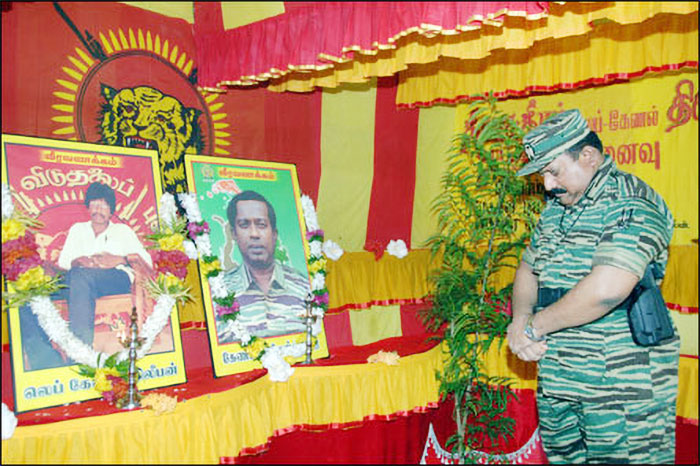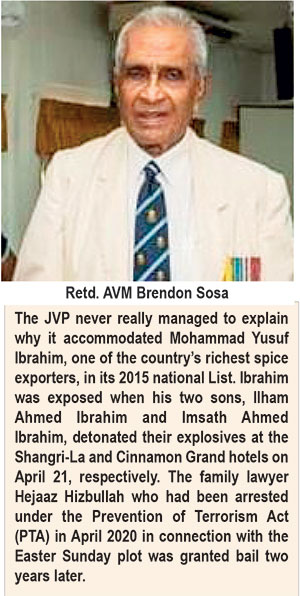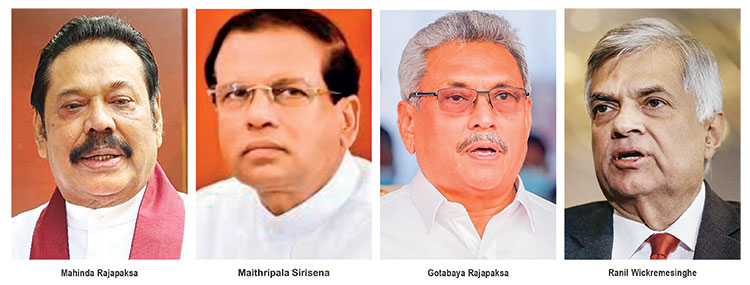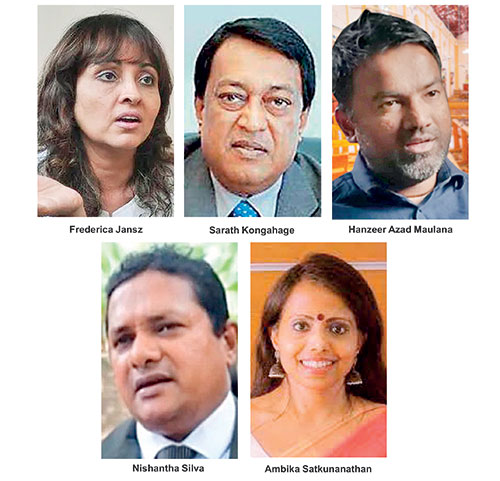SPECIAL REPORT : Part 489
By Shamindra Ferdinando
The Parliament last week wasted two days on a much hyped debate on national security and the 2019 Easter Sunday carnage carried out by local Muslim extremists radicalized by ISIS ideology. The debate didn’t help political parties represented in Parliament to reach consensus on the post-Easter Sunday reconciliation plan.
But, the ruling ‘Pohottuwa’ party and the solitary UNP National List MP Wajira Abeywardena defended the handling of the Easter Sunday investigations, whereas those who were in the Yahapalana Cabinet, that ruled the country at the time, attacked the Wickremesinghe-Rajapaksa government over its alleged failure.
A careful consideration of speeches made on September 21 and 22 clearly reflected the fact that political parties remained committed to their original positions, though the political landscape has changed. The exchange between former President Maithripala Sirisena, MP, and war-winning Army Commander Field Marshal Sarath Fonseka, MP, on the first day of the debate, underlined the pathetic state of affairs.
Polonnaruwa District ‘Pohottuwa’ lawmaker Sirisena’s claim that the war veteran wouldn’t have received the Field Marshal’s rank without his intervention proved again he didn’t have any sense of what he was talking about. If not for Fonseka’s strategic, courageous, ruthless and relentless leadership in pursuit of his goal to destroy the Tigers, the LTTE wouldn’t have collapsed in less than three years (Aug 2006-May 2009) though the successful war effort hinged on the combined forces commitment, and leadership in their respective fields.
MP Sirisena owes an explanation as to why wartime Navy and Air Force commanders, Wasantha Karannagoda and Roshan Gunathilake, respectively, were denied honorary ranks of Admiral of the Fleet and Marshal of the Air Force when Fonseka was awarded the rank of Field Marshal in March 2015. Karannagoda and Gunathilake finally received their due honours in Sept. 2019, several months after the Easter Sunday carnage, the subject of the two-day debate that didn’t achieve anything.
Lawmaker Sirisena should be reminded that he held the public security portfolio as the then President and Commander in Chief at the time of the Easter attacks. Sirisena steadfastly refused to swear in an UNPer as Public Security Minister though he reluctantly swore in Ranil Wickremesinghe as the Premier after the Supreme Court thwarted his constitutional coup. In fact, an influential section of the Yahapalana setup wanted Fonseka appointed as the Public Security Minister, though the proposal didn’t find favour with Premier Wickremesinghe.
While Parliament debated the Easter Sunday carnage, President Ranil Wickremesinghe, who served as the Premier at the time of the near simultaneous suicide attacks, was away in Washington to attend the 78th sessions of the UN General Assembly in New York. Let me reproduce verbatim the assessment made by the Presidential Commission of Inquiry on the Easter Sunday carnage. “Upon consideration of the evidence, it is the view of the CoI that the lax approach of Mr. Wickremesinghe towards Islamic extremism, as the Prime Minister, was one of the primary reasons for the failure on the part of the then government to take proactive steps towards Islamic extremism. This facilitated the build-up of Islamic extremism to the point of the Easer Sunday attack.” (Final report, Vol
01, p 276-277).
Against the backdrop of lawmaker Sirisena seeking UN intervention following the Channel 4 allegations, based on Hanzeer Azad Maulana (ex-aide to State Minister Sivanesathurai Chandrakanthan aka Pilleyan) over claims of complicity of Maj. Gen. Suresh Sallay in the Easter Sunday plot, it would be pertinent to point out the CoI’s assessment on the then President Sirisena. “Upon consideration of evidence of facts before 4th April 2019, the CoI is of the view that President Sirisena has failed in his duties and responsibilities and that his failure transcends beyond mere civil negligence.” (Final report, Vol 01, p 263)
CoI suggested: “….based on the evidence, the CoI is of the view that there is criminal liability on his part for the acts or omissions explained above. The CoI recommends that the Attorney General consider instituting criminal proceedings against President Sirisena under any suitable provision in the Penal Code.” (Final report, Vol 01, p 265)
Supreme Court Justice Janak de Silva chaired the CoI. The other members of the CoI were Court of Appeal Judge Bandula Karunaratne, retired Court of Appeal Judge Sunil Rajapaksa, retired High Court Judge Bandula Atapattu and retired Justice Ministry Secretary W.M.M.R. Adikari. The CoI commenced its hearings on Oct. 31, 2019 and sat on 214 days in total, holding 640 sittings and interviewing 451 witnesses.
The ‘Pohottuwa’ caused suspicions among the Catholics by appointing a six-member team to study the report prepared by such an eminent group. The group, headed by Chamal Rajapaksa, and included Johnston Fernando, Udaya Gammanpila, Ramesh Pathirana, Prasanna Ranatunga and Rohitha Abeygunawardena, was named on Feb. 19, 2021. President Gotabaya Rajapaksa received the report on Feb 01, 2021.
The Catholic Church repeatedly pointed out that none of the recommendations made by the CoI had been implemented.
Retired AVM doubts C4 claims
Air Vice Marshal [retired] A.B. Sosa V S V, psc, emphasized the pivotal importance of what he called maximum possible legal punitive action against those responsible for the attacks and security failure at all levels.
The former coordinating Officer of the Hambantota District at the height of the JVP-inspired insurgency (1987/88) and Mahiyanganaya in 1989 where the JVP declared a curfew to sabotage President Ranasinghe Premadasa’s Gam Udawa project explained how various interested parties exploited the developing situation to their advantage.
Declaring that the Easter Sunday carnage is a crime against humanity, Sosa examined the sequence of events as presented by C4, based on Hanzeer Azad Maulana, ex-CID Officer Nishantha Silva, who sought political asylum in Switzerland a week after Gotabaya Rajapaksa’s election as the President in Nov. 2019, and an anonymous Sri Lankan Government Official.
C4 accusations pertained to the period about four years prior to the Easter bombings. They rely on the accusations of Maulana and Nishantha Silva. C4 dealt with circumstances Pilleyan’s involvement in the murder of a sitting Member of Parliament Joseph Pararajasingham while attending holy mass on Christmas day 2005. That killing took place in Batticaloa.
One-time LTTEer and sidekick of Karuna Amman who served Mahinda Rajapaksa’s parliamentary group had been entrusted with the task of eliminating those opposed to the Rajapaksas, according to Moulana, who lucidly explained the role played by his former boss over the years.
Sosa questioned Moulana’s claim that Pilleyan’s group had been accommodated at the former Tripoli market premises and was named the ‘Tripoli Platoon.’ The former Director of Operations and Training declared: “This is an outrageous claim. As there had been an Army detachment therein, a motley crowd of civilians couldn’t have been positioned there under any circumstances. Such a situation is not possible in any disciplined military organization.”
Reiterating his concerns over the failure on the part of successive governments to punish those responsible for the assassination of Sunday Leader Editor Lasantha Wickrematunga in January 2009, the Air Force veteran said that Moulana’s claim that the wartime Defence Secretary Gotabaya Rajapaksa directed the so-called Tripoli ‘platoon’ to eliminate the eminent journalist is nothing but a blatant lie.
Sosa said that the ex-CID officer’s unsubstantiated claims regarding the Wickrematunga assassination and his removal from the investigation should be examined against the backdrop of his failure to produce any documents or incriminating tapes. The retired AVM emphasized decisions couldn’t be made or consensus reached merely on a statement. Reference was made to an unprecedented Swiss Embassy ‘drama’ that followed the CID officer leaving the country along with his family.
During his career, Sosa, who had received training in the UK and Pakistan, held several command appointments, including as the Commander of the Katunayake Air Force Base.
Commenting on the alleged meeting arranged by Moulana between Sallay and the would-be Easter Sunday suicide bombers in a coconut estate called Lactowatta in the Puttalam district in Feb. 2018, Sosa emphasized this allegation should be examined taking into consideration the officer concerned was based in Malaysia as Sri Lanka’s Minister Counsellor. Sallay is on record as having said that he never left Malaysia in 2018 to visit Sri Lanka or any other country. Sosa stressed that Sallay, who had served as head of the Directorate of Military Intelligence (DMI) at the time of the 2015 presidential election, was removed and sent out of the country. Malaysia could help Sri Lanka and other interested parties to establish/ascertain the then Minister Counsellor’s movements. Sosa said: “Sallay could not have been simultaneously in two countries.”
The retired AVM also disputed C4 claim that Moulana had received instructions from Sallay on April 19, 2019, over the phone on the basis the officer was on a National Defence College, India, course. The government and other interested parties could easily verify this with Indian authorities, Sosa said, pointing out that both Malaysia and India must have examined claims.
The retired officer said: “In such circumstances, it is obvious that some ill-considered notions had been accepted by C4. Did C4 engage in a deliberate project to discredit Sri Lanka? I hold no brief for anyone. I have never met those who had been interviewed by C4 or persons mentioned, including Maj. Gen. Suresh Sallay. There is absolutely no doubt that the heinous Easter Sunday attacks and other allegations must be thoroughly investigated and perpetrators punished. However, it is necessary to sift out red herrings such as the farcical so-called C 4 hatchet job meant to discredit Sri Lanka. Perhaps, C4 is among those who pursued a different agenda as they couldn’t stomach our victory over terrorism.”
Sosa retired in Aug. 1990 on reaching the mandatory 55 years, several weeks after the eruption of Eelam War 11. Having successfully met the JVP challenge in the hotbed of subversive activities, where he served as CO for a year, Sosa received appointment as Base Commander, Karunayake, even though the Security Council wanted him appointed as CO, Kegalle. Sosa recalled how President Ranasinghe Premadasa, having succeeded JRJ, sent him to Mahiyangana to neutralise the JVP threat to facilitate the holding of Gam Udawa there. “Immediately after I took over security at Mahiyangana, President Premadasa met me there. We had a very cordial one-to-one meeting. The President told me to ensure that power supply was not interrupted and normalcy restored. The JVP had sabotaged the entire fleet of around 30 buses in the depot. I flew down motor fitters and mechanics from Katunayake air base who got the buses going by cleaning the sand spiked gear boxes and oil tanks. Army troops were placed on 24-hour patrols to ensure the power pylons were not destroyed by the JVP. These troops had to be maintained by helicopters as the area was not accessible by road. During the Gam Udawa period, President Premadasa met me every morning. The Gam Udawa drew a large crowd and everything went off well except for a minor incident after closing time on one occasion. When leaving in the morning after the final day the President said “Thank you, see me in Colombo.” Sosa said that he opted to get back to Katunayake air base and remained there until retirement.
The Thileepan affair
Amidst the ongoing controversy over the Easter Sunday carnage and ahead of the two-day debate in Parliament, a vehicle carrying a portrait of Thileepan was attacked by villagers at Shardhapura, Uppuveli.
Thileepan died of a hunger strike at Nallur Kandasamy Kovil on Sept. 26, 1987. His fast lasted 11 days. A section of the media reported that National List MP Selvarajah Kajendran (a member of the Gajendrakumar Ponnambalam led Ahila Illankai Thamil Congress) accompanying the vehicle was also attacked. It would be pertinent to mention that Kajendran first entered Parliament in 2004 on the Tamil National Alliance (TNA) ticket. The one-time President of the Jaffna University Students Union received the backing of the LTTE at that election in the wake of the TNA recognizing Velupillai Prabhakaran as the sole representative of the Tamil speaking people, amidst the shocking split caused by then LTTE Eastern Commander Vinayagamoorthy Muralitharan aka Karuna Amman defecting to the government.
The portrait-carrying vehicle began its journey at Pottuvil and was on its way to the Jaffna peninsula, where the final remembrance was to be held. A section of the media depicted Thileepan as a person who died for the rights of the Tamil speaking people.
Let us examine the circumstances 26-year-old Thileepan died following the 11-day fast after Velupillai Prabhakaran ‘deployed’ him as a suicide bomber. Actually, Thileepan’s fast unto death was meant to cause mayhem in the Jaffna peninsula. The LTTE mounted its first suicide attack on July 05, 1987, on the Nelliady Army detachment.
Former LTTE terrorist Niromi de Soyza (adopted pseudonym) dealt with Thileepan’s fast unto death, in her debut as a writer. ‘Tamil Tigress’ first published two years after the Sri Lankan military decimated the LTTE’s conventional military capability, the writer, who had been 17 at the time she joined the group in 1987, discussed Thileepan’s death against the backdrop of Velupillai Prabhakaran’s decision to take on the Indian Army. Sri Lanka was forced to accept the deployment of the Indian Army in late July 1987.
The writer ‘Niromi’ questioned Velupillai Prabhakaran’s choice as Thileepan was physically fragile and too intelligent to be sanctified. She had been one of those assigned for crowd controlling duties at Nallur Kandasamy Kovil where she witnessed Thileepan being welcomed onto the makeshift podium. The LTTE’s No. 02 at the time Mahattaya had been with Thileepan at the launch of his fast. ‘Niromi’ had been at the scene of the hunger strike on many days and experienced the LTTE propagating the lie that the dying man’s wish was for the LTTE to defeat the Indian Army. Recalling the opportunity she received to get onto the podium, the writer translated four lines of a Tamil song heard about a week after Thileepan launched his much advertised action.
A sweet-smelling flower is withering
It cannot speak, it cannot walk
Will Thileepan anna’s desire be satisfied?
Won’t the foreign army flee?
The writer named Thileepan as the person who conscripted her, handed her first assault rifle as well as a cyanide capsule which the writer called kuppie.
She had been present when a doctor who examined Thileepan on Sept. 26, 1987, pronounced him dead.
‘Niromi de Soyza’ wrote: With his life Thileepan had paved the way for war (Chapter 09: There’s still time to change your mind).
Less than 10 days after Thileepan’s death, the Sri Lanka Navy intercepted a trawler carrying a group of hardcore LTTE terrorists in the northern seas. Their detention and their subsequent mass suicide in Sri Lankan custody led to the resumption of war in the second week of Oct. 1987.
Niromi de Soyza quoted Velupillai Prabhakaran as having told a group of cadres, including herself, soon after the mass suicide at Palaly, “The Indian government engineered the so-called peace process as a plot to gradually eliminate us.”
Propaganda war will continue unabated until Sri Lanka countered lies. Fifteen years after the conclusion of the war, Sri Lanka is still struggling to counter various narratives. There cannot be a better example than the bid to exploit deliberately caused Thileepan’s death to launch a fresh rift between the Sinhalese and Tamil speaking people. The vehicle convoy that had been launched from Pottuvil was meant to cause maximum harm to these yet fragile relations. Unless the government takes tangible measures against such exploiting tactics to create fresh wounds between the two communities, the day the country erupts again is not far off.

 Air Vice Marshal [retired] A.B. Sosa V S V, psc, emphasized the pivotal importance of what he called maximum possible legal punitive action against those responsible for the attacks and security failure at all levels.
Air Vice Marshal [retired] A.B. Sosa V S V, psc, emphasized the pivotal importance of what he called maximum possible legal punitive action against those responsible for the attacks and security failure at all levels.
 Whoever had been at the helm, the Government of Sri Lanka was determined not to set the record straight, both locally and internationally. The war-winning Rajapaksa administration and the Wickremesinghe-Sirisena government, that co-sponsored the treacherous 30/1 US-led resolution in Oct. 2015 against one’s own country, refrained from addressing specific issues. The Gotabaya Rajapaksa government was definitely the worst. Instead of mounting a proper defence, it merely declared the country’s withdrawal from that resolution.
Whoever had been at the helm, the Government of Sri Lanka was determined not to set the record straight, both locally and internationally. The war-winning Rajapaksa administration and the Wickremesinghe-Sirisena government, that co-sponsored the treacherous 30/1 US-led resolution in Oct. 2015 against one’s own country, refrained from addressing specific issues. The Gotabaya Rajapaksa government was definitely the worst. Instead of mounting a proper defence, it merely declared the country’s withdrawal from that resolution.